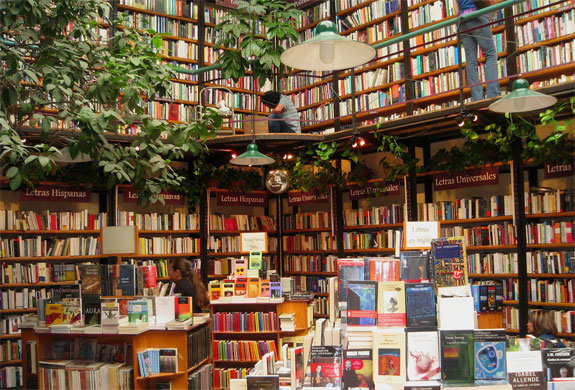
- Not shelf after shelf piled with books, spines facing out
- Not row after row of color-coordinated tupperware bins
- Not a book display that has housed the same books for two months
The problem is, you know what you don't want in a library. (See above list) You do want a library that kids will clamor to enter and beg you to visit instead of recess or snack time or puppies and rainbows. In short, you want your library to be simply dreamy. That's all you're asking.
But seriously- building a classroom or home library that will entice your child to read and keep him/her motivated long-term can be a daunting task. If it's done right, you will not only be burning tons of brain power deciding what kinds of books to include or how many to include or how to organize them (although those are all important considerations), but what the library conveys. Does it say, "Come in- This library is the same today as when you first visited (and also when your little brother was in this class)." Or does it say, "Welcome! Step right up to see which new worlds are available for travel today. Get it while it's hot!" I would argue that what a library conveys to its potential readers is the first- and most important- consideration in putting together a library.
So put down your matching bins and your cute little labels. For this first step, all you need is your imagination. To get started, make a picture in your mind of your favorite local bookstore...
A book seller's job is to sell books, in much the same way that it's our job as parents and teachers to "sell" books. To do this, they don't simply shove all their books on shelves, spines facing out. Nor do they put every single book uniformly in a basket or tub. No. When you enter a bookstore, you are greeted with colorful, varied cover-out displays. There are tables with books standing up. There are shallow shelves meant to show off the covers of best sellers. There are recommended sections, sections by interest, sections organized alphabetically, and my personal favorite "If you liked, then try..." displays. I don't know about you, but almost as soon as I walk through the threshold of any gloriously curated bookstore, I'm touching books and reading flaps within minutes.
We know that kids (and adults!) are more likely to take a book when the cover is showing. We know that even disorganized people appreciate thoughtful organization when it comes to objects they care about. We know that children take cues from the way that the adults in their lives treat books.
So if we want our kids to enjoy books and reading, one of the first places we can start is with our home or classroom libraries. If, in the corner of your child's playroom, you've got an old bookshelf that is puking bent, ripped books from its sagging shelves, you may want to think about a make over. Because right now, your library is saying, "Stay away, or you'll catch what I have." If, hidden beside your board games and old worksheets, you have 10 dusty tupperware bins of golden books and Disney and Spongebob, you may also want to think of a make over. Your library is sending the "This-section-of-the-room-is-in-a-time-warp" vibe, and it's not cool. We want books and reading to be cool. Right??
So get down to your nitty-gritty library daydreams. Like any successful bookstore, displays are vibrant: flexible and changing in order to keep the interest of their customers.
So get down to your nitty-gritty library daydreams. Like any successful bookstore, displays are vibrant: flexible and changing in order to keep the interest of their customers.
I could talk for days on this topic, but for now, start with this checklist as you revise your home or classroom library:
- What kinds of colors and/or finishes do you want to look for in storage in order to convey the feel that you want for library? If it's meant to be a cozy place to curl up and stay, you might choose different materials than if it's meant to be a vibrant, stimulating place.
- What kinds of creative seating or cozy nooks can you plan so that readers want to stay?
- In what ways (if any) will you involve your children in planning the space?
- How many books is age-appropriate for having available at once? Could some be stashed away to build enthusiasm later?
- What kind of varied storage makes the most sense for your age group? (Not just tubs and not just a display shelf)
- Where can you make space for cover-out displays?
- Where ELSE can you make space for cover-out displays?
- How can you honor - and feature- the well-loved favorites that your child wants to read again and again?
- Can you include a basket or ledge that is "owned" by the children? i.e. They decide what to put in and why.
- What will your minimum goal be for sprucing the library up by rotating new books into the line up? Change it with the holidays? Refresh it quarterly? Where will the old books go and where will the new ones come from?
 |
Here's a picture of part of my son, Finn's library. He's 8 months at the writing of this post, so his library is pretty distributed throughout the house. I have baskets in two of the downstairs rooms which we read from during the day and before naps. In his bedroom, he has his board book section (pictured) and a whole bunch of picture books for later, housed up high, (not pictured) since they aren't appropriate for munching. All around his room, he has books propped up.
Finn is crawling, so the books that he mostly looks at are on the bottom self, laid out in a way that he can get them and put them back (yeah right!!). The ones in the green tub are the ones that I am reading aloud most before bedtime. The ones on the two shelves above are ones that will be interesting to him soon, but not yet.
And here's a beginning of the year picture of my classroom a year or so ago. Like Finn's library, the class library was spread throughout the classroom (because of traffic and space), but this was the main library area where all our read alouds and Reader's Workshop meetings took place. You can see that I tried to have room for both functional book bins as well as cover-out displays that changed. Since it was the beginning of the year, I was featuring a popular back to school author, but that display area was often changed based on the author, genre, or topic we were studying. At the beginning of the school year, we "open" baskets slowly. The baskets that are labeled and illustrated by the students were open at this time, while the blank bins were yet to be introduced.
I urge you to think about a future library in your mind before you take the leap. Think big and imagine all the possibilities. Daydream before you ever start putting books into piles or making cute basket labels. Because building a library is not an exercise in sorting- it is much, much more than that.





.jpg)
Comments
I just happened to stumble across your blog and I LOVE, LOVE, LOVE your son's room! We did my son's room with a "book" theme too! If you don't mind me asking, what color did you use on the walls and where is that AWESOME chair from??? Thanks! Can't wait to keep reading! :)